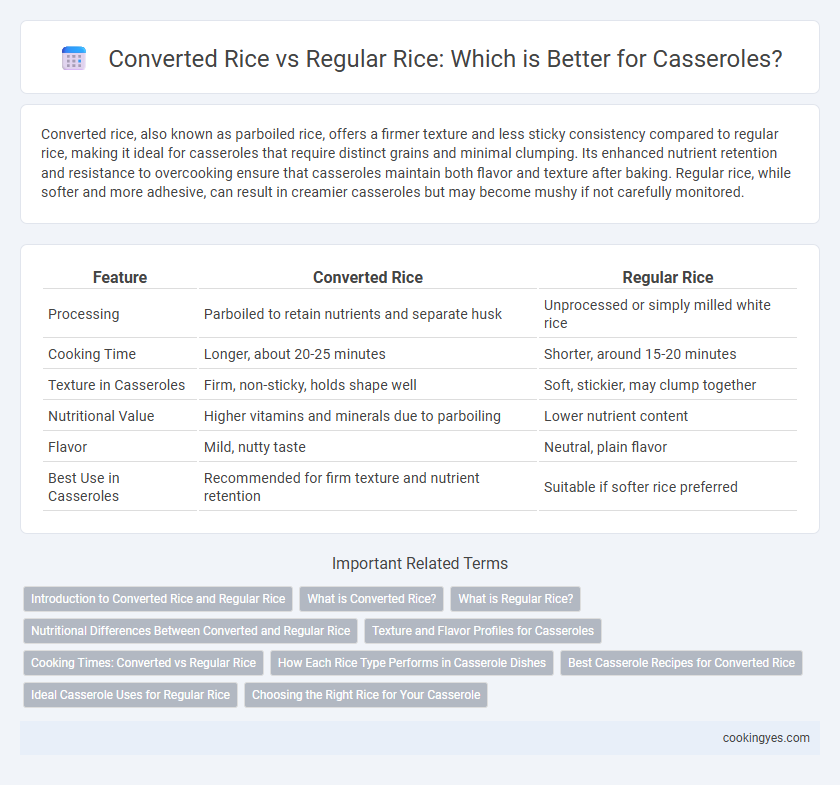Converted rice, also known as parboiled rice, offers a firmer texture and less sticky consistency compared to regular rice, making it ideal for casseroles that require distinct grains and minimal clumping. Its enhanced nutrient retention and resistance to overcooking ensure that casseroles maintain both flavor and texture after baking. Regular rice, while softer and more adhesive, can result in creamier casseroles but may become mushy if not carefully monitored.
Table of Comparison
| Feature | Converted Rice | Regular Rice |
|---|---|---|
| Processing | Parboiled to retain nutrients and separate husk | Unprocessed or simply milled white rice |
| Cooking Time | Longer, about 20-25 minutes | Shorter, around 15-20 minutes |
| Texture in Casseroles | Firm, non-sticky, holds shape well | Soft, stickier, may clump together |
| Nutritional Value | Higher vitamins and minerals due to parboiling | Lower nutrient content |
| Flavor | Mild, nutty taste | Neutral, plain flavor |
| Best Use in Casseroles | Recommended for firm texture and nutrient retention | Suitable if softer rice preferred |
Introduction to Converted Rice and Regular Rice
Converted rice, also known as parboiled rice, undergoes a unique soaking, steaming, and drying process that enhances its nutrient retention and firmness, making it ideal for casseroles requiring distinct grain separation. Regular rice, typically white or long-grain varieties, lacks this processing and can become softer or stickier when cooked, influencing the texture of casserole dishes. Understanding these differences helps in selecting the best rice type for casseroles where consistency and moisture absorption play crucial roles.
What is Converted Rice?
Converted rice, also known as parboiled rice, is rice that has been partially boiled in the husk, which enhances its nutritional value and changes its texture. This processing method causes the grains to become firmer and less sticky, making it ideal for casseroles where distinct grains are preferred. Compared to regular rice, converted rice absorbs flavors better and maintains its shape during baking, resulting in a fluffier, less mushy casserole dish.
What is Regular Rice?
Regular rice refers to raw, uncooked grains that require soaking or rinsing before cooking, commonly used in casseroles for their ability to absorb flavors and maintain a slightly firm texture. This type typically includes varieties like long-grain white rice, brown rice, and jasmine rice, each offering distinct cooking times and moisture levels affecting the final casserole consistency. Unlike converted rice, regular rice retains more of its natural starch, which can influence the dish's creaminess and cohesiveness.
Nutritional Differences Between Converted and Regular Rice
Converted rice, also known as parboiled rice, retains more nutrients compared to regular white rice due to its unique processing method that drives vitamins and minerals from the bran into the grain. It contains higher amounts of thiamine, niacin, and magnesium, making it a more nutritious option for casseroles where preserving vitamins is important. Regular rice, especially white rice, loses significant amounts of nutrients during milling, resulting in lower fiber and micronutrient content compared to converted rice varieties.
Texture and Flavor Profiles for Casseroles
Converted rice, also known as parboiled rice, offers a firmer texture and less sticky consistency compared to regular white rice, making it ideal for casseroles that require distinct grains and a fluffier finish. Its nutty flavor profile enhances casserole dishes by providing a subtle depth without overpowering other ingredients, whereas regular white rice tends to have a milder taste and softer texture, which can result in a creamier, more cohesive casserole. Choosing converted rice improves the structural integrity of casseroles, preventing them from becoming overly mushy during baking or reheating.
Cooking Times: Converted vs Regular Rice
Converted rice, also known as parboiled rice, requires a longer cooking time of about 20 to 25 minutes compared to regular white rice, which cooks in approximately 15 to 18 minutes. The parboiling process partially gelatinizes the starch in converted rice, making it firmer and less sticky, which benefits casseroles that need distinct grains and a firmer texture. Regular rice tends to absorb moisture more quickly, potentially leading to softer, sometimes mushier casseroles if not closely monitored during cooking.
How Each Rice Type Performs in Casserole Dishes
Converted rice retains more nutrients and has a firmer texture, making it ideal for casseroles that require distinct, separate grains. Regular rice tends to become softer and more tender, absorbing flavors well but sometimes resulting in a creamier, less structured casserole. The choice between converted and regular rice impacts moisture retention and overall texture, influencing the dish's consistency and mouthfeel.
Best Casserole Recipes for Converted Rice
Converted rice, also known as parboiled rice, retains more nutrients and holds its shape better than regular rice, making it ideal for casseroles that require extended baking. Its firmer texture prevents mushiness, ensuring that dishes like chicken and rice casserole or cheesy broccoli rice bake maintain perfect consistency. Best casserole recipes for converted rice often highlight its ability to absorb flavors deeply while remaining fluffy, enhancing the overall dish quality.
Ideal Casserole Uses for Regular Rice
Regular rice is ideal for casseroles requiring a fluffy, separate grain texture that absorbs sauces well without becoming overly soft. Long-grain varieties like Jasmine or Basmati maintain their structure during baking, providing a light and airy consistency perfect for layered or mixed casseroles. Its natural starch content helps bind ingredients while retaining a distinct grain integrity, enhancing both flavor and presentation in casserole dishes.
Choosing the Right Rice for Your Casserole
Converted rice, also known as parboiled rice, maintains more nutrients and stays firmer when cooked, making it ideal for casseroles that require a fluffy texture without becoming mushy. Regular rice varieties, such as long-grain or basmati, tend to absorb more liquid and can become softer or stickier, which may be preferable for creamier, more cohesive casseroles. Selecting converted rice ensures a consistent grain separation, while regular rice offers a softer bite depending on the desired casserole outcome.
Converted Rice vs Regular Rice for Casseroles Infographic

 cookingyes.com
cookingyes.com